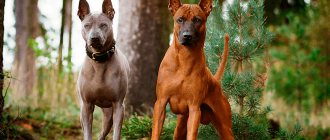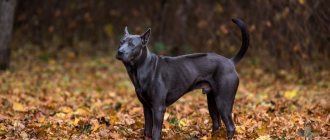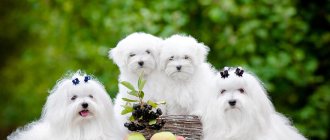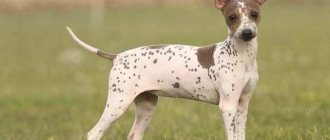The Thai Ridgeback is a large, athletic dog with a short velor coat and a clearly defined ridge on the back. The rare exotic breed belongs to the category of pariahs of uncertain origin and has survived to this day almost unchanged. Let's find out what a Thai Ridgeback is and what are the specifics of keeping this dog.
Description of the Thai Ridgeback breed
Popularity 130th place among 263 dog breeds
Lifespan:
about 13 years old
Height:
males: 61-66 cm, females: 56-61 cm
Country of origin:
Thailand
Average price:
from 1000 euros
Weight:
23-32 kg
Latest articles Cat health
Rabies vaccination for cats: choice of vaccine, necessity, schedule 01/22/2022 4 0 0
Selection and adaptation
TOP 20 best cat breeds for families with children 01/22/2022 25 0 0
Advantages and disadvantages
- Pros:
- intelligence, intelligence, ease of training and learning;
- cleanliness and intelligence;
- endurance, energy;
- friendliness and boundless devotion to the owner.
- Minuses:
- highly developed hunting instinct - the dog can break off the leash and chase birds and other animals;
- independent and willful character;
- aggression towards other people's pets;
- predisposition to colds and obesity.
Breed diseases
The Thais do not yet have many generations of crossbreeding in order to obtain an exact match to the standard, therefore in their blood they have a predisposition to only two diseases:
- Hip dysplasia develops in dogs that weigh too much and jump too high - at some point the joint capsule is damaged and the paw becomes twisted. To fix this, surgery will be required.
- The dermoid sinus develops during intrauterine development - the skin is formed incorrectly, as a result of which an ulcer forms on it, as if turned inside out.
There are no more predispositions: neither to allergies, nor to diseases of the sensory organs, nor to disturbances in the functioning of the gastrointestinal tract. Thais live on average 12-13 years.
Key facts
The Thai Ridgeback, or MahTai, is a striking medium-sized dog similar in appearance to the wild dingo dog. This is an ideal friend for a large active family and a kind, caring “nanny” for small children. The animal gets along well with cats and dogs, although it may perceive turtles, rodents and birds as prey.
Description of the Thai Ridgeback breed combines:
- activity;
- friendliness, sociability;
- excellent memory and intelligence;
- cleanliness;
- remarkable guard abilities.
Animals get along well with family members, including small children, but such contact should always be supervised by adults. MahTai tries to avoid conflict situations, but does not tolerate rude treatment.
The dog can be kept in a country cottage with a large fenced area or a small apartment under one condition - physical activity during walking must be serious.
Characteristics of the Thai Ridgeback breed include a lot of factors:
- Origin: Indonesian coast of Thailand.
- Breed Registrations - The East Asian Canine Association standardized the native breed in 1982, FCI recognized it in 1983.
- Character traits - an intelligent, peace-loving animal avoids conflicts and unnecessary worries, and is able to quickly respond to danger threatening family members.
- With the right diet and maintenance, the life expectancy of the Thai Ridgeback is about 13 years, and health problems in the dog are rare.
- Care is not complicated or painstaking.
Due to their delicate, soft skin and short hair, animals do not tolerate cold well, so you should take care in advance of having clothing in cold weather. They love warmth and comfort, preferring to bask on a bed or in a chair.
Thais do not like water; they rarely swim in a lake or river, even in sunny and hot weather. The puppy will need to be accustomed to bathing procedures from childhood.
Mating
As a rule, Thai Ridgebacks are bred at the age of about 2 years. Participating animals are those that have breed data confirmed by titles, are suitable for breeding and do not have health problems.
Clubs in which dogs are registered, or owners of kennels, select candidates for intended matings in advance, based on data, desired colors, etc. It happens that there is an appointment for puppies from a couple whose meeting has not yet taken place.
Available candidates for mating can often be seen on nursery websites. Because In Russia, Thais are not yet so numerous; often applicants have to be looked for abroad, which, naturally, is a rather expensive undertaking. In addition to travel costs, the owner will need to pay for tests and the mating itself.
History of the origin of the Thai Ridgeback
The history of the aboriginal breed goes back hundreds of centuries. Archaeological research shows that the Thais appeared more than 4 thousand years ago. Their ancestors were most likely dingoes. MahTaya with erect triangular ears, a characteristic crest (ridge), and a sickle-shaped tail can still be seen today in rock art.
The first evidence of the breed is found in the chronicles of the 17th century, where Ridgebacks are described as strong, fast, intelligent and loyal dogs of various colors with a characteristic crest on the back. At that distant time, they were used to protect homes from rats, snakes and when hunting wild boars, deer, and birds.
In addition, animals accompanied carts on trips around the peninsula. The isolated lifestyle of the inhabitants of Siam (aka Thailand) contributed to the preservation of the original appearance of the breed, and natural selection allowed the survival of the strongest and bravest individuals, who are still in excellent health today.
The development of the transport system made it possible to learn about Ridgebacks and the rest of the world. After massive deforestation and the cessation of hunting on the peninsula, animals began to be used as guards, watchmen, and heavy load tractors for shepherds, where they proved themselves to be the best. Today in Thailand, MahTai are an indicator of the high status in the society of their owner.
After the first puppy was transported to Holland (1990), the breed has been gaining popularity around the world. By the beginning of 2003, only 365 individuals of the ancient breed were registered.
Today dogs are successfully conquering the whole world, bred in the USA, EU, Asia, England and other countries. But even in our time, their number is relatively small - about 3 thousand, which is why MahTai dogs are considered elite and expensive.
Appearance of the Thai Ridgeback
General impression
It is easy to notice from the photo that Thai Ridgebacks are unusual, incredibly beautiful animals of medium size with well-developed muscles, a short and soft coat formed along the back by a ridge - a strip of wool that grows in the opposite direction and differs from the rest of the skin in color, length and form.
Head
Due to its origin, it is similar to a wolf's head. The forehead line is sloping, skin folds appear on it when the dog is interested or wary.
The skull has a rounded shape, thickened in the ear area. The muzzle is straight, its size in the Thai Ridgeback is 60% of the length of the entire head.
The dog has powerful jaws with strong fangs. Thin lips are pressed tightly to the teeth. Ridgebacks have a spotted tongue.
On the dog's head, medium-sized ears are widely spaced and slightly tilted forward. The shells are open, the tips are pointed. Cropping of ears is prohibited.
Large almond-shaped eyes are set deep. Dry eyelids are adjacent to the eyes, their cut is oval. Breeders value the brown color of the iris; amber color is also acceptable.
Neck
The pet's neck is muscular, set proudly and quite high. There is a slight bend, no suspension. The strength and power of the muscles can be easily felt with the fingers through the skin.
Torso
Slightly elongated in length, straight and strong back smoothly transitions into the lower back, rounded croup. The long ribs form an oval sternum that reaches to the elbows. The animal's groin area and abdomen are tucked up.
Front and hind limbs
The shoulder blades are protruded back. The forearms flow smoothly into the pasterns, their slight slope is clearly visible in profile. The dog's hind and front metatarsals are oval, all the toes are crowded. The pads are quite hard. The claws are strong, with light or dark patches.
The animal's hips are well developed. The angles of the hock joints are low and pronounced.
Tail
The tail, thick near the back, tapers to a tip. The dog holds it strictly vertically. When at rest, the tail drops to the hock joint.
Movement
Thais walk confidently, maintain a clear rhythm, and do not throw their limbs to the sides, which provides them with a strong springy push. Movements are light and free; when walking, the joints are parallel to one another.
Wool
Dogs have a short, soft body coat. There is no undercoat. The wool is shiny and resembles expensive velor. It is divided into several categories:
- Very short
– coarse hair 0.2-0.3 centimeters long covers the entire body, the animal does not look very presentable from the outside - a little bald. Such a cover is not able to protect the dog from insect bites; the body is often “decorated” with blisters and red spots.
- Average
– the length of the hair is 0.6-0.7 centimeters, it is soft and pleasant to the touch, and performs an excellent protective function.
- Short
– hairs up to 0.9 centimeters long are considered an intermediate species between the first and second types.
- Standard
– hair length is 0.9-2.4 centimeters, wool is able to protect the animal from insects and from drafts in the cold season.
The key feature of the elite breed is its pronounced “comb”. Its length should be no more than ¾ of the length of the back. A deviation of a few centimeters is allowed, which is not a defect in the standardized breed.
Thai Ridgeback colors
According to the breed standard, MahTai can have four coat colors:
- Red
– the most common tone, which can vary from light red to rich burgundy. The tone does not have pronounced transitions; it is lighter in the abdomen and hips.
- Black
- happens with a brown, olive, brown tint, which is evenly distributed throughout the body. Due to the fact that black color can overpower any other colors, it is not popular among breeders.
- Blue
– can be gray-smoky, dark and light-tender. Puppies that have white and light spots on the chest are discarded from the litter.
- Deer
– cocoa, tea rose, cream, pink tone. These dogs' fur shimmers in the light. A light spot in the chest area is acceptable.
But these are not all modern Thai colors. On the peninsula you can find chocolate, tiger, and even dirty green animals. But the most popular coat color is red, as the people of Thailand associate it with wealth and good luck. Less popular is black, which is the color of death.
Thai Ridgeback size
The height of the Thai Ridgeback at the withers in adulthood reaches 55-60 centimeters in males and 52-57 centimeters in females. Thai Ridgeback weight: males - 33 kilograms, females - 25 kilograms.
Historical reference
It is quite difficult to say how many millennia the history of the Ridgeback breed dates back to; according to the generally accepted version, dogs with ridges on their backs have existed for more than 3,000 years. It is possible that aboriginal dogs, which can be considered the ancestors of Ridgebacks, lived before, but there is no scientific data confirming this version. Similar uncertainty exists in determining the birthplace of the breed. Officially, the first habitat of the breed group was mainland and island Thailand, but it is possible that Ridgebacks also lived in Indonesia. Most likely, the Thai Ridgeback dog originated from uncontrolled inbreeding of wild Dingoes and aboriginal canines. Dingoes, in turn, are descendants of wolves that lived in Asia. In a modern analogy, Ridgebacks would be considered a semi-wild mongrel cross.
This is interesting! The main concentration of the ancestors of Thai Ridgebacks was observed in the east of the coastal zone of Thailand, and the dogs came to the islands while traveling with fishermen and traders.
Climatic conditions forced the animals living on the islands to “get rid” of their fur and heavy build. Generation after generation, nature “mowed down” individuals unsuitable for survival. The final type of Thai mongrels is quite similar to the description of the modern Ridgeback breed, of course, if we omit the nuances regarding the uniformity of colors and dimensions. History is silent at what exact stage the inbreeding with Dingo occurred, but the similar morphology (the science of structure and shape) of dogs is obvious. By the way, the remains of dogs similar to Dingo were found both in Vietnam and Thailand. According to archaeological research, dingo-like dogs (usually called wolves) lived in the above territories 5–5.5 thousand years BC.
This is interesting! The world community recognizes the wild roots of the Thai Ridgeback, since the breed belongs to the aboriginal (naturally occurring) FCI group.
Traveling by sea, semi-wild dogs with a ferocious but loyal disposition ended up on the island of Phu Quoc, located in the Gulf of Thailand (Vietnam). The limited and small area of the territory led to forced inbreeding, that is, closely related mating among dogs. Thus, in an absolutely natural, albeit slightly unnatural way, the islanders acquired a universal working breed.
This is interesting! Historians claim that, unlike Dingoes, who lived in the western part of the land, wolf-like dogs in the East were domesticated and bred under human control even before our era.
The indisputable fact of selection is confirmed by both ancient finds of archaeologists and written references depicting Ridgebacks at the time of primary progress. It is known that the aboriginal ancestors of the breed had a rather serious disposition, that is, they could pose a danger to people, most likely to their owners. Against this background, it is described that this incredibly strong, dexterous, attentive and resilient dog was so faithful that, having caught game on its own, it always brought it to its owner. The selection of producers made it possible to reduce the risk of aggression and improve the working qualities of Ridgebacks. Judging by rock paintings and frescoes, even in those times when writing was not developed, four-legged animals were used as hunters, shepherds, guards and draft animals.
This is interesting! The ancient Dingoes, which are close ancestors of the Thai Ridgeback, are, to one degree or another, considered the progenitors of at least half of the breeds known today.
And Ridgebacks would live happily ever after, leading their ordinary yard lifestyle if not for... progress. In the 19th century, the island of Phu Quoc (Phu Quoc) attracted the attention of the colonialists, and travelers and traders from Europe followed them. Arriving on the islands, lovers of four-legged animals already “savvy” in the basics of cynology discovered dogs with ridges. It is quite difficult not to notice the strip of fur growing in the opposite direction along the entire back of the animal. The obvious conclusions took dog connoisseurs by surprise; it was obvious to everyone who met Thai Ridgebacks that there are no similar breeds in Europe.
Now you have a completely logical question: why are Ridgebacks called Thai and not Vietnamese? On the back of all representatives of the breed there is a ridge formed as a result of a gene mutation. There is a theory that the wider and longer the dog’s coat comb, the more generations of Ridgebacks are “inscribed” in its pedigree. In addition, according to this theory, the number of “crowns” of the ridge also indicates a multi-stage origin. Having studied dogs in the territories of Thailand and Vietnam, scientists concluded that Thai Ridgebacks are older, their ridge affects not only the back, but also the sides. The number of crowns of the Thai Ridgeback reaches 16 pieces, while dogs from the territory of Vietnam have a crest only on the back, and a maximum of 10 crowns.
Personality of the Thai Ridgeback
MahTai dogs are ideal companions for active families and single people. These are open, very sociable, friendly animals that completely trust their owner. Thai Ridgebacks happily take part in everything that happens around them. They quickly learn to distinguish people's moods and easily accept the rules and proposed daily routine.
Becoming a wonderful companion for loved ones, dogs are wary and cold towards strangers. The guest will have to try hard to earn the attention and affection of a strict, aloof pet. Innate distrust makes dogs excellent watchdogs and protectors.
Despite their strong attachment to their owner, the animals remain completely independent. They will never impose themselves or demand special attention to their person. Dogs value affection, love and care, prefer to be in the center of events, but at the same time tolerate loneliness well. Dogs rarely bark and only remind themselves of themselves with a quiet grunt when necessary.
Having a developed intelligence and lively temperament, Thais quickly and easily learn new information, achieving success in training. But fruitful results are achieved exclusively through soft, friendly and interesting cooperation.
Dogs will not tolerate rude and unfair treatment. They will simply stop accepting and listening to a person who begins to use physical force. A self-sufficient, intelligent dog is able to assess the situation and make the right decision. The owner needs to treat him with respect, trust and understanding.
The character of the Thai Ridgeback is peaceful and accommodating; over the years, pets become full-fledged members of the family, delighting household members for many years. But if inside the house the dog is “friends” with cats and other pets, there is no point in hoping that the same behavior will be outside the house.
MahTai has a well-developed hunting instinct - the dog is capable of starting a conflict on the street. In addition, dogs love to divide the surrounding animals into “us” and “strangers”. After which they sympathize with some, ignore others, and growl at others for no reason.
But the selective friendliness of the Thai cannot be compared with the boundless love for small family members. They will never offend the baby and will endure all pranks with enviable calm. Animals derive great pleasure from open and sensitive communication.
History of the breed
The Thai Ridgeback is an ancient native breed that lived throughout Thailand, Vietnam, Cambodia and Indonesia. The second name is MahTai. Belongs to the group of pariah dogs, which are characterized by uncertain origins. In Russia they are called mongrels. The MahTai is the national breed of Thailand.
The name Ridgeback is derived from the English words “ridge” - “comb” and “back” - “back”. It is explained as follows: a woolen “track” stretches along MahTai’s back, the pile on which grows in the opposite direction.
The origin of the breed cannot be determined. However, genetic analyzes have shown that Ridgebacks who lived in Thailand are older than their Cambodian and Vietnamese relatives. The isolation of Thailand prevented crossbreeding with other breeds, so the modern MahTai is not much different from the ancient “variant”.
Historical purpose of the breed: hunting, home guarding, cargo transportation. Ridgebacks are known for their ability to hunt on their own. They were a good help in the household because they could feed not only themselves, but also the owner.
The Thai Ridgeback received recognition from the FCI only in 1993. This breed is rare in Russia: about 400 animals are officially registered.
Education and training
Ideally, it is best to start raising and training a Thai Ridgeback from 1.5 months of age. But in real life this is impossible to do, since many nurseries sell puppies after 3 months of life. Kids quickly get used to new living conditions, and there should be no concessions at this time. Use only diplomacy and perseverance - rigidity and passivity should be completely excluded.
Ridgebacks have high intelligence, but, like many dog breeds, intelligence is accompanied by stubbornness, willfulness, and independence. The right approach to training and the tips below will help you raise an excellent life partner:
- In education, it is necessary to immediately establish a hierarchical relationship between the dog and the breeder, to show who is boss in the home. In all actions, the head of the family must demonstrate superiority - enter the house first, serve food first, etc., the actions of the animal must be performed only after his approval.
- Training should be carried out consistently: the rules and basic commands must be clearly understood and immediately followed by the dog. This will require strong will and tolerance. If you are not confident in your own abilities, it is better to use the help of an experienced dog handler.
- Remember that an improperly raised Ridgeback will try to dominate all members of the family. There are cases where the dog behaved aggressively, growled and rushed at people. Such individuals cannot be re-educated.
- At the age of 4-5 months, a teenager needs to be taught basic commands and instilled in the principles of correct behavior in society. To do this, it is better to use food, play and social motivation.
The result of the training should be strict execution of all commands. The dog should not act at its own discretion; if necessary, punishing the pet is allowed (but not with physical force). Splashes of water, a loud shout, clapping your hands, a light blow with a wooden stick, a rolled-up newspaper or a towel on the back - something that will help point out the wrong behavior to your pet.
Important! Ridgebacks are very sensitive, rude and tactless treatment causes them to be withdrawn, aggressive and distrustful of others. The best results in training can be achieved with encouragement in the form of dog treats and affection.
Looking for a Thai Ridgeback? Find your pet from 2 offers Buy
Trainability
Thai Ridgebacks are highly trainable. Taking into account the psychological characteristics of the breed, when raising it, it is necessary to adhere to several principles:
- it is important to observe regularity and consistency of training;
- you need to train often, without long breaks;
- It is important to start training as early as possible;
- Ridgebacks are sensitive to respect for fairness, so the owner should never
- one cannot be inconsistent in punishments and rewards;
- This is a serious and dangerous breed with a developed protective instinct, so it is important to develop in the dog the skill of instantly responding to the owner’s command in any conditions.
Health and disease of the Thai Ridgeback
Centuries-old natural selection played a major role in the development of the indigenous breed. Ridgebacks have good health and rarely get sick.
Possible diseases
Most of the MahTai's problems are related to their special body structure. The most common diseases of the Thai Ridgeback are:
- Dermoid sinus - There is no complete separation between the spinal cord and the skin, resulting in the formation of a thread-like opening that extends all the way to the vertebra. It can form in the cervical region or along the entire midline of the back. It periodically becomes inflamed, which promotes the proliferation of bacteria on the skin. The defect is difficult to detect at an early age, but is eliminated by surgery.
- Incorrect formation of the hip joint - the head of the femur does not fully fit into the socket, which causes severe pain in the animal, preventing it from moving normally. Regular monitoring and the addition of symptomatic slow-acting medications to the diet are required.
- Problems with the gastrointestinal tract of a very different nature.
- Hypothermia and, as a result, a cold.
In the above cases, dogs are excluded from further breeding. To prevent infectious diseases, vaccination is used, which is carried out according to the generally accepted scheme.
In addition, dogs have eczema and dermatitis, obesity associated with poor diet, and cardiovascular diseases. All this can be avoided with proper care and regular visits to the veterinarian for a routine examination.
Reproductive health
Ridgebacks are animals with a sense of dignity and independent character. A bitch can react aggressively even to a permanent male dog, after which mating is out of the question. Breeders advise introducing animals earlier so that they can get used to each other.
Having become pregnant, the bitch becomes affectionate, calm and loving. At this time, she requires increased attention, frequent walks in the fresh air with minimal physical activity. If this is not taken into account, there is a high risk that the animal will not accept the puppies after birth.
Childbirth usually occurs between 57 and 62 days, it is good if a veterinarian is present, as complications often arise in bitches.
If you do not plan to breed the breed, it is recommended to undergo sterilization or castration. The operation to remove the reproductive organs is performed in the clinic under anesthesia; complications after this are practically zero.
Character and intelligence
The Ridgeback dog has a freedom-loving, independent character, so only an experienced and knowledgeable dog handler can become its friend and owner. Extravagance of appearance is an important, but not the only difference from dogs of other breeds:
- She is characterized by amazing tenacity of character, which borders on stubbornness.
- The dog cannot be retrained. A loving and selfless owner can work with her.
- Despite this character trait, animals are very loyal and devoted to their owners.
- They are family favorites.
- The breed is distinguished by a subtle mental organization, so rude attitude and shouting cause mental trauma and resentment to the animals.
Ridgeback is the owner of developed intelligence:
- He is observant, endowed with analytical abilities, distinguishes voices and intonations of speakers, and listens to the conversation.
- If his nickname is uttered, the dog will not take his eyes off the speaker, and folds will appear on his forehead, indicating participation in the “dialogue.”
- Dogs' moods are changeable and inconsistent: after getting ready for a walk, they can go to bed.
They adapt perfectly to the rhythm of life of their owners. They do not tend to obsessively ask for a walk, but daily walking is mandatory for them.
Attitude towards children and others
Dogs are not fans of communicating with strangers and treat them with caution:
- do not wag their tail;
- do not accept affection;
- They prohibit stroking with a growl.
But they will not make selfless watchdogs, since they are not aggressive. Ridgebacks warn of the appearance of strangers, but do not attack.
The dog gets along well with family members and pets:
- She can sleep peacefully with the cat without chasing him.
- Does not challenge leadership with other dogs living in the yard.
- But on a walk, it is better for all these animals not to approach her, given his hunting instinct, although she herself does not begin to sort things out first.
- At this moment, you cannot let the dog off the leash, because it will simply run away without hearing the owner’s commands.
- Animals have the most cordial relationships with children.
- They play and walk together, and the dog does not scare the children with his growls and grins.
Games and walks should not be short, in them the dog fulfills its need for physical activity.
Important! It is not advisable to leave children unattended with a dog in order to avoid trouble; there is also no need to trust children with raising a dog. The animal will relax; it needs a firm hand from its owner.
Features of feeding and diet
Thais can be given dry food or natural food, the main thing is not to mix them. It is better to choose balanced premium food, since cheap analogues provoke inflammation of the gastrointestinal tract. The best today are:
- "Go";
- "Origen";
- "Bosch"
- "Akana";
- "Hills".
You can see many other brands on sale, and your veterinarian will tell you which one to choose. Feeding your dog natural food requires drawing up the right menu, which includes all the components necessary for a healthy and fulfilling life.
MahTai dogs can be given:
- raw, lean beef;
- boiled poultry fillet;
- offal;
- cartilage;
- cereal porridge;
- boiled fish without bones;
- stewed, fresh vegetables;
- fruits and greens;
- low-fat fermented milk products;
- occasionally raw chicken yolks.
The main thing in Thai nutrition is developing the right menu. Dogs quickly get used to the established regime and only in rare cases rebel and refuse to eat. In this case, there is no need to panic, since the dog will eat everything anyway.
The animal should always have fresh water in the required quantity.
Learning ability
Before training, the Ridgeback requires socialization - getting to know other people and animals.
To teach your dog commands, establish rules in the house from the first day the puppy arrives. Treat your puppy as an equal, but don't give in to him. When training, be cunning - force the dog to perform exercises in different sequences, change the course of actions, introduce new commands. Do not adapt to your Ridgeback: if he sits incorrectly, correct him; if he barks, silence him.
Train your dog to calmly respond to incoming guests. He has a ringing voice - it will be unpleasant for you if the Ridgeback constantly barks when greeting those who enter.
Care and maintenance
Ridgebacks are ideal for keeping in a city apartment. They don’t smell like “dog”, and when they shed every year, there is practically no hair. Only a few tablespoons of wool can be collected from short-haired individuals. Excessive hair loss is a reason to contact a veterinary clinic to take a scraping and identify subcutaneous mites.
Caring for an animal's coat is very simple - brushing is done several times a week with a brush with natural bristles or a rubberized glove. They will quickly remove lost hairs and improve the animal’s subcutaneous blood circulation.
Since MahTai does not have an undercoat, it is better to keep the dog in a warm room without drafts. In cold weather, your pet needs to be dressed in clothes, otherwise he may catch a cold.
In the care and maintenance of the Thai Ridgeback, it is worth noting that dogs do not like to swim, they do not tolerate humidity and dampness, so walks in the rain should be avoided. If you encounter bad weather along the way, you can be sure that the pedantic animal will bypass all the puddles and remain clean. He will only need to wipe his paws from dirt and wrap him in a warm blanket.
The dog is bathed once a month in warm water with a special shampoo; there should be no drafts in the room. The ears are cleaned of wax and dirt with a cotton pad soaked in a special hygienic lotion or weak boric acid. No less attention is paid to the eyes - the characteristic discharge in the corners is removed in the morning and evening with a cotton swab and chamomile decoction.
Stone may form on the teeth, so for the purpose of prevention, they are cleaned with a brush and a special paste several times every 7 days. Regular pastes cannot be used, as they foam, have an unpleasant taste and smell for the dog, and can cause irritation of the oral mucosa.
Elite breed dogs are active, very energetic, and usually sharpen their own claws on the asphalt when walking. But you can help them with this - keep the limbs in warm water for a while (this will soften the hard tissue) and use forceps to remove the excess length.
The dog's paw pads also require regular inspection - they can crack and be injured by sharp, hard objects. In the first case, a rich cream will help, in the second - antiseptics.
Care instructions
Caring for a Ridgeback is quite simple. Therefore, minimal actions will be enough to keep the dog in order:
- You can brush your teeth every other day using a special brush and toothpaste. With a natural diet, you can add cartilage to your diet, which will clear stones.
- In winter, after molting, dogs suffer greatly from the cold, so it is best to dress them in special suits or overalls for walks.
- You should only bathe your dog when necessary. On other days, just wipe your paws. The wool can be combed with a rubber brush. These dogs do not really like water, so they need to be accustomed to it from childhood.
- Nails are trimmed once every two weeks. The procedure should also be taught from childhood.
- If necessary, clean your ears with special means.
It is important to choose the right diet for your dog. You can feed your pet dry food, but then it is better to choose super premium food. If you want to give natural food, then you should use lean meat, vegetables and a variety of cereals. Before creating a diet, it is best to consult with a specialist. It is important not to overfeed the animal, but at the same time provide it with all the necessary minerals and vitamins.
Purebred puppies should only be purchased from trusted breeders.
Tips for choosing a puppy
Despite the elite nature and rarity of the breed, it is quite possible to buy it in Russia. But first you need to decide on the purpose of the purchase - whether the puppy will take part in exhibitions and breeding or become a pet. Its price and the choice of an official nursery will depend on these parameters.
Upon arrival, be sure to familiarize yourself with the parents’ achievements and documents, and carefully examine the puppy. Ideally, he should be moderately well-fed, have the correct color, shiny eyes and glossy fur with folds, show activity and interest in those present.
When choosing a Thai Ridgeback puppy, special attention is paid to the condition of the joints. The breeder must prepare documents for the dog: a veterinary passport with notes on deworming, vaccinations and metrics, which will be changed to the pedigree.
The baby is taken from the mother at the age of 3 months, when the initial rules of behavior have been formed. For the arrival of a new family member, you need to prepare toys, bowls, a soft and beautiful leash.
Breeders recommend adopting a puppy from official nurseries and under no circumstances from hand - only in this case can you count on the animal being purebred. The most famous institutions in the Russian Federation:
- Showline Melins Kennel, Moscow;
- Nellirel, Klin;
- GrAmySweet, St. Petersburg;
- Elfgrais, Kaluga;
- Mythaidog.
Each has its own advantages and characteristics; before visiting a particular nursery, it would be appropriate to familiarize yourself with the achievements, history, and customer reviews.
How to choose a puppy
All dogs require attention and love from their owner, and the Thai Ridgeback is a good example. This bundle of indomitable energy needs proper education, training and daily walks. Are you ready to devote every free minute to your pet? Now all that’s left to do is choose the right puppy!
The first step towards acquiring a four-legged friend is selecting a specialized nursery. Look for organizations that provide the necessary information about the puppy's parents. If they don’t have a single title at their disposal, think about it: most likely, the reason lies in invisible vices that will certainly affect the kids.
A professional breeder provides a veterinary passport, a leaflet for the future Ridgeback owner and FCI documents. The puppy must be branded, vaccinated and wormed in a timely manner. When getting to know your litter, pay attention to the most active and moderately curious baby - he is destined to become your companion! And don't be put off by the Shar Pei's skin folds: they will disappear as the dog gets older.
How much does a Thai Ridgeback cost?
The MahTai breed is elite and rare, especially in the CIS. The price of a Thai Ridgeback starts at 1,000 euros and can reach 30,000 euros. It is determined by the baby’s pedigree and the parents’ achievements.
It is not recommended to purchase an adult dog, even if he has all the documents. The Ridgeback will not have time to get used to the new owner and will resist following commands.
If you go shopping at the poultry market, you are unlikely to find a balanced and healthy animal there.
Do you like the article? 0
Purchasing a puppy and prices
Finding a purebred Ridgeback is not so easy. Only a few kennels breed these dogs, so the cost of puppies is quite high. The breeder must provide all the necessary documents for the dog and show pedigrees. It is important that puppies are vaccinated and treated for parasites. It is important that the kids are active and there are no signs of illness.
It should be borne in mind that puppies at a low price may not always be the exact breed you need, so you should not trust such offers.
The Thai Ridgeback is a beautiful dog with an original appearance. The dog will become an excellent friend and guard. He takes well to children and other pets, but can be stubborn and self-willed. Easy to train, loves active games and walks. This dog will attract the attention of any person on the street.











